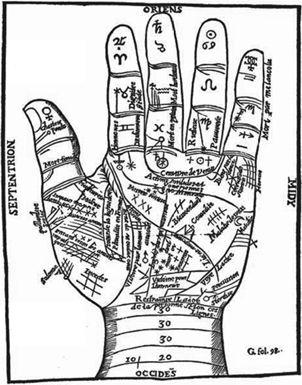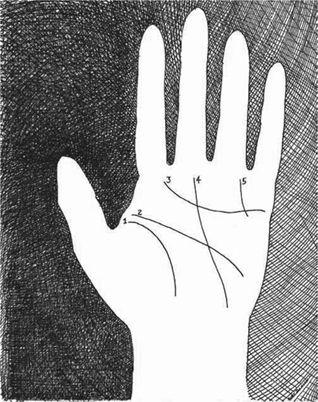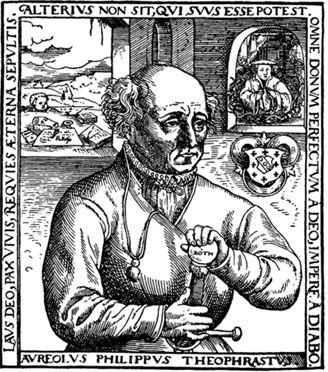The Sorcerer's Companion: A Guide to the Magical World of Harry Potter (58 page)
Read The Sorcerer's Companion: A Guide to the Magical World of Harry Potter Online
Authors: Allan Zola Kronzek,Elizabeth Kronzek

 f Harry’s left palm is any indication, he may have very little time left on this Earth. At least that’s what it sounds like when Professor Trelawney begins her lesson in palmistry by announcing that Harry has the shortest life line she’s ever seen. So much for tact.
f Harry’s left palm is any indication, he may have very little time left on this Earth. At least that’s what it sounds like when Professor Trelawney begins her lesson in palmistry by announcing that Harry has the shortest life line she’s ever seen. So much for tact.

Palm reading could be very complicated
. A
detailed map of the human hand from 1640 shows the relationship between the signs of the zodiac and the lines on the palm
. (
photo credit 62.1
)
Palmistry, also known as
chiromancy
(from the Greek
cheiro
, meaning “hand,” and
mancy
, meaning
“prophecy”
), is a complex method of fortune-telling and character analysis based on the lines on a person’s palms and the shape, size, and texture of their hands. This system of
divination
probably originated in India and is at least five thousand years old. It was practiced in ancient China, Tibet, Persia, Mesopotamia, and Egypt. Legend holds that the Greek philosopher Aristotle, who described the hand as the “principle organ” of the body, taught palmistry to his most famous pupil, Alexander the Great. Julius Caesar is said to have thought himself so skilled at deciphering palms that he judged his men by the appearance of their hands.
Although the ancients praised the merits of palmistry, systematic guides to the art were not developed until the Renaissance. The first complete manual on the subject,
The Chiromantic Art
, appeared in Germany in 1475, not long after the invention of the printing press. In this and many works that followed, readers could find detailed maps of the hand that gave names and specific meanings to each line, pad (or “mount”), and valley on the palm. Analysis of these details was said to provide clues not only to a person’s character and destiny but also to his or her risk for heart trouble, liver disease, and other illnesses. In the seventeenth century, courses on palmistry were on the curriculum of several major universities.
Palm reading reached its heyday at the end of the nineteenth century with the rise of its most famous practitioner, Count Louis Hamon. Working in London under the professional name of Cheiro, Hamon conducted thousands of readings each year, using a system he had learned from his Irish mother. He developed a reputation for remarkable accuracy and attracted many notable clients, including kings Edward VII and Edward VIII of England, King Leopold of Belgium, Czar Nicholas II of Russia, Grover Cleveland, Thomas Edison, Mark Twain, and Oscar Wilde. The excitement stirred by Hamon’s successes has never quite faded, and professional palm readers still thrive throughout much of Europe and the United States.

Most palm readers examine both hands. The left is said to reveal an individual’s inherited characteristics, while the right indicates choices to be made and the victories and defeats that lie ahead. Each line and mount on the palm is examined separately, but a complete reading takes into account the collective meaning of all features of the hand.
A glance at your own hands will reveal dozens of lines, long and short, bold and subtle. Many elaborate systems of palmistry attribute significance to each line, as well as to the distance between lines and the ways in which lines cross one another. But every system begins with these principal lines:

1.
THE LIFE LINE
:
Contrary to popular belief (and Professor Trelawney’s implication), this line does not indicate how long a person will live, but provides a general picture of the subject’s quality of life and vitality. A strong downward curve, even in a short line, indicates physical strength; a relatively straight line suggests limited endurance.
2.
THE HEAD LINE
:
This reflects a person’s intellectual capacities. It reveals creative potential, powers of concentration, and problem-solving skills. A long line indicates the ability to focus.
3.
THE HEART LINE
:
This line provides the key to understanding emotions. It reveals the subject’s style of interacting with others and his or her expectations regarding love and relationships.
4.
FATE LINE
:
This line indicates the degree of control one exercises over one’s life and circumstances. It also reveals how well a person handles responsibility and makes use of innate talents.
5.
THE APOLLO LINE
:
Sometimes known as the Line of the Sun, this line measures inner contentment. Not everyone has an Apollo line, but when it appears it’s a sign of a capacity to enjoy life and derive satisfaction from work. In some systems, a long Apollo line indicates good luck.


 bust of his venerable head occupies an honored place in the hall-ways of Hogwarts. His countenance animates a Chocolate Frog Witches and Wizards card. And the details of his colorful and turbulent life are no doubt known to all fifth-years considering a career in the healing arts. His real name was Philippus Aureolus Theophrastus Bombast von Hohenheim, but as a real-life wizard and physician, he is best known by the Latin name he gave himself—Paracelsus.
bust of his venerable head occupies an honored place in the hall-ways of Hogwarts. His countenance animates a Chocolate Frog Witches and Wizards card. And the details of his colorful and turbulent life are no doubt known to all fifth-years considering a career in the healing arts. His real name was Philippus Aureolus Theophrastus Bombast von Hohenheim, but as a real-life wizard and physician, he is best known by the Latin name he gave himself—Paracelsus.
Born in 1493 in the town of Einsiedeln, Switzerland, Paracelsus grew up immersed in the magical and medical practices of his day. His father, Wilhelm, was a country doctor with an interest in alchemy (see
Sorcerer’s Stone
) and from him Paracelsus learned about the healing power of plants and gems, and how the stars and planets radiated their influence into every aspect of earthly life (see
Astrology
and
Magic
). Although the family was poor, Wilhelm collected books on magic, and Paracelsus was an eager student. He also gained practical experience collecting herbs and plants and learned how to turn them into medicines according to “the doctrine of signatures,” which taught that the medicinal value of a plant was revealed by its shape or color (see
Herbology
). From his father’s practice in nearby mining towns, Paracelsus learned the basics of metallurgy and studied the properties of iron, tin, mercury, and other metals—knowledge that he later put to use in creating new medicines. He also interviewed local peasants, shepherds, and “wise women” about the folk remedies that had been handed down for generations. His willingness to ask questions and try new treatments became the hallmark of Paracelsus’ future work.
